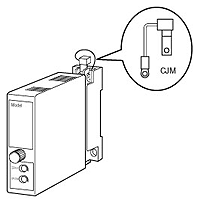| EAP-031030 |
| Thermocouples / Cold Junction Module |  |
All M-System Thermocouple Input Temperature
Transmitters are "married" to  their
respective plug-in bases and cannot be indiscriminately moved from base
to base. their
respective plug-in bases and cannot be indiscriminately moved from base
to base.As you may recall, Thermocouples (T/C) are nothing more than a pair of dissimilar metal wires joined at a point called a junction. This results in the self-generation of a tiny repeatable emf in the low mv range. This emf is based on the Periodic Table Activity Parameter that is unique with each element. This tiny emf generated is consistent within metal types (chosen for their activity) and proportional to the temperature at the dissimilar metal junction. Because of the repeatability of this physical phenomenon, industry has compiled standardized emf vs. temperature tables for those certain standardized metal type pairs we call thermocouples. The Type nomenclature, Type J, Type K, etc,. is a function of the specific metals chosen for the temperature range measurement. Now, the emf differential relative to temperature is tiny and is measures in 4-place decimal point notation, the 5th decimal place is often interpolated. No, remember that every dissimilar metal junction generates a tiny emf. When these active metal T/C lead wires are attached to transmitter or controller, another junction exists, generating yet another emf that is in series with the actual process temperature emf. This creates a significant error in actual temperature measurement, and needs to be offset to maintain accuracy. The normal widely used offset scheme is a CJM, or Cold Junction Module. This CJM is always at the actual copper to dissimilar terminations, and consists of a precision variable resistance device which is also temperature responsive, and serves to offset the secondary emf at the termination junction. Now, since the CJM is included in the measuring circuit when the transmitter is calibrated, it in effect is match, or "married" to the specific module. You will note that each CJM is marked with the same serial number of its parent module, and cannot be interchanged. Many times, customers will install all the bases in a panel first, and then later plug-in the modules. Remember, that the transmitter module calibration is accurate ONLY with the original CJM. Mixing will result in signification temperature reading errors. Any and all measurement or calibration of T/C modules must always incorporate the matching serial number CJM. |
| M-System has flexible solutions to meet your specific application and requirements. Consult our Signal Conditioners Data Library. |
| Copyright © 2003 MG Co., Ltd. All rights reserved. |